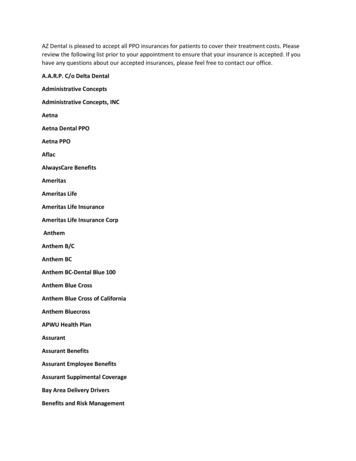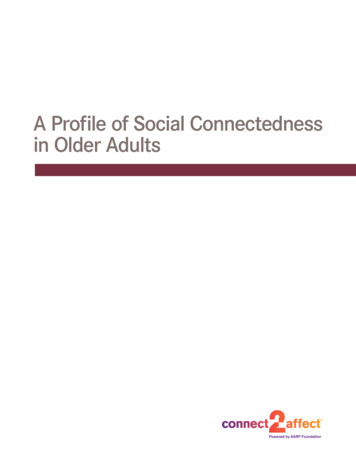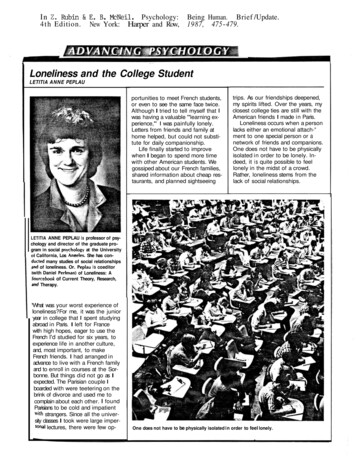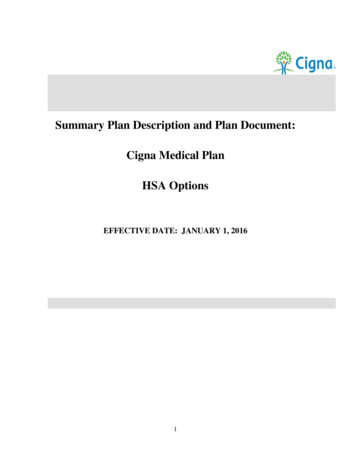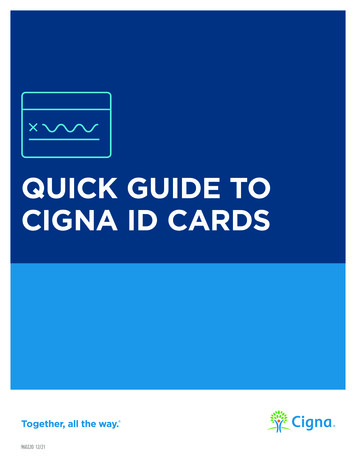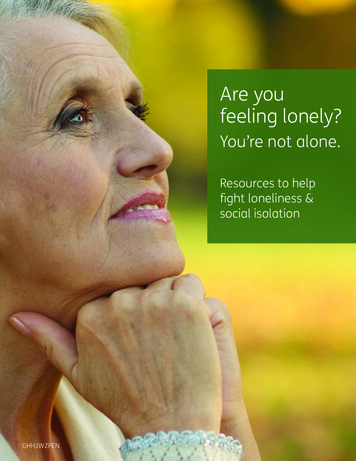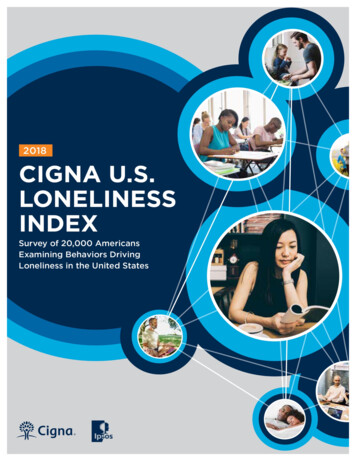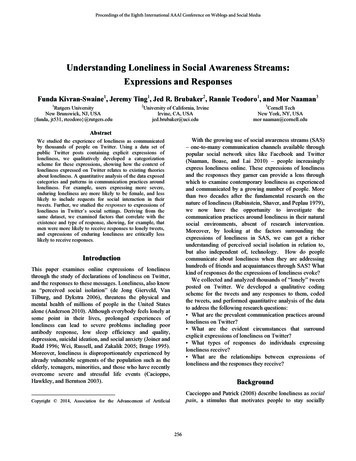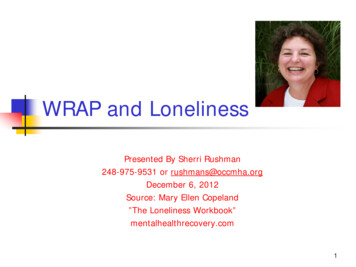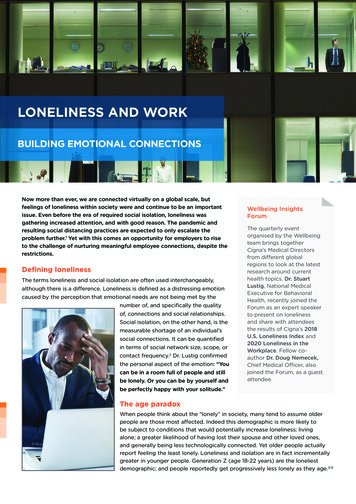
Transcription
LONELINESS AND WORKBUILDING EMOTIONAL CONNECTIONSNow more than ever, we are connected virtually on a global scale, butfeelings of loneliness within society were and continue to be an importantissue. Even before the era of required social isolation, loneliness wasgathering increased attention, and with good reason. The pandemic andresulting social distancing practices are expected to only escalate theproblem further.1 Yet with this comes an opportunity for employers to riseto the challenge of nurturing meaningful employee connections, despite therestrictions.Defining lonelinessThe terms loneliness and social isolation are often used interchangeably,although there is a difference. Loneliness is defined as a distressing emotioncaused by the perception that emotional needs are not being met by thenumber of, and specifically the qualityof, connections and social relationships.Social isolation, on the other hand, is themeasurable shortage of an individual’ssocial connections. It can be quantifiedin terms of social network size, scope, orcontact frequency.2 Dr. Lustig confirmedthe personal aspect of the emotion: “Youcan be in a room full of people and stillbe lonely. Or you can be by yourself andWellbeing InsightsForumThe quarterly eventorganised by the Wellbeingteam brings togetherCigna’s Medical Directorsfrom different globalregions to look at the latestresearch around currenthealth topics. Dr. StuartLustig, National MedicalExecutive for BehavioralHealth, recently joined theForum as an expert speakerto present on lonelinessand share with attendeesthe results of Cigna’s 2018U.S. Loneliness Index and2020 Loneliness in theWorkplace. Fellow coauthor Dr. Doug Nemecek,Chief Medical Officer, alsojoined the Forum, as a guestattendee.be perfectly happy with your solitude.”The age paradoxWhen people think about the “lonely” in society, many tend to assume olderpeople are those most affected. Indeed this demographic is more likely tobe subject to conditions that would potentially increase loneliness: livingalone; a greater likelihood of having lost their spouse and other loved ones,and generally being less technologically connected. Yet older people actuallyreport feeling the least lonely. Loneliness and isolation are in fact incrementallygreater in younger people. Generation Z (age 18-22 years) are the loneliestdemographic; and people reportedly get progressively less lonely as they age.3-6
Why loneliness matters to employersDr. Lustig summarised a key finding of the Cigna research: “There’sa very robust finding that there is a decrease in loneliness as ageincreases.” Therefore, it is actually people of working age who reportfeeling most lonely. Indeed, Cigna research has also found that over60% of employees stated that they feel lonely.4Lonely workers say theyare less engaged and lessproductive, and report lowerretention rates.Loneliness is bad for businessCigna research on Loneliness and the Workplace 2020 discovered that loneliness amongst employees is actually verybad for business. Lonely workers say they are less engaged and less productive, and report lower retention rates.They are twice as likely to miss a day of work due to illness or family commitments, and five times more likely to misswork due to stress. When asked about quality of work, 12% of lonely workers said they believe their work is lowerquality than it should be compared to just 4% of non-lonely workers. Furthermore, it was found that loneliness mayalso result in attrition issues; lonely workers say they think about quitting their job more than twice as often as nonlonely workers.4 As Dr. Lustig commented “People tell us in this survey that if they’re lonely they tend to miss moredays of work per year, and there’s a real dollar cost to that. It matters to the organisation if people are missingwork, and it certainly has an impact on productivity too.”Impact of COVID-19 employee protection measuresNew procedures in the workplace such as social distancing, long-term working from home, and restrictions onsocialising are vital to limit the risk of further outbreaks of COVID-19. Yet the enforced estrangement, by its verynature, damages many of the previous workplace rituals that createdthe fabric of social connections amongst employees. Dr. Lustigemphasised some of these issues, commenting: “In COVID times,we are dealing with other things. Social distancing being a big one,particularly for people living alone, who are already isolated, areworking remotely, who don’t get the chance to out and interact.”Loneliness is often thought about in terms of separation from familyand loved ones, yet employees often spend more time with theircolleagues than anyone else. Changes to the workplace can thereforehave a significant effect on an individual’s support network, andconsequently their wellbeing.Loneliness is bad for healthThere is a growing body of evidence that having a lack of socialconnections has a negative impact on health. It is not surprisingto find that loneliness is associated with inferior mental healthoutcomes.7 In the UK,people living on theirown report lowerPhysical conditions that canlevels of happinessbe exacerbated by lonelinessand higher levels ofinclude heart disease,anxiety than thoseliving with a partner.8stroke, and dementia.7,119Loneliness is also cited as a significant factor in depression.More unexpectedly, the risk to mortality that loneliness can bringis similar to the risks associated with other known factors; such asobesity, smoking, or physical inactivity, which currently garner greater attention and extensive health resources.10Physical conditions that can be exacerbated by loneliness include heart disease, stroke, and dementia.7,11 The waysin which loneliness can affect health are multifaceted, and are thought to be a combination of physiological andbehavioural impacts.12Lack of “social buffering”It has been suggested that social support can create a “social buffering” that can limit the effects of stress on health.Loneliness can have the opposite effect of “social aggravating”, thereby worsening the physiological impact ofstress.13
Effect on behaviourFeeling lonely has been associated with an increased incidence of unhealthy behaviours such as low fruit andvegetable intake, smoking, and being physically inactive.14 A recent study of heart failure patients found that lonelypeople were less likely to follow therapeutic recommendations, such as taking exercise.15 There is also a link betweenloneliness and poor sleep quality and insomnia.16 Over time, impaired sleep increases the risk of developing seriousmedical conditions, such as obesity, heart disease and diabetes, and can even shorten life expectancy.17Biochemical pathwaysResearch has not yet identified all the physiological pathways affected by loneliness, although possible mechanismsfor the increased risk of ill health do include the disruption of the regulation of stress-related hormones, such ascortisol.18 Designed to help the body deal with immediate stressors, cortisol can increase heart rate, blood pressure,and blood glucose, while shutting down other functions. Highcortisol levels can be linked to anxiety and depression.19 Anotherhormone that may be affected by loneliness is oxytocin.12 SometimesFollowing a strategy toknown as the ‘love hormone’ due to its involvement in attachmentreduce loneliness couldand social functioning, oxytocin also has a role in metabolicregulation and feeding behaviours.20 Dr. Nemecek highlighted thehelp to foster meaningfulsignificance of touch in human connections, “We’re social distancingconnections despitenow, and it impacts our ability to actually be in the same roomas people. And not just seeing – but also touching people – iscoronavirus-relatedimportant. The importance that handshakes have played over therestrictions.years; and how giving your friend a hug when you see them has anincredible emotional connection.”What can an employer do to reduce loneliness?To combat loneliness in the workplace, an organisation should makeemployee connections a priority. As Dr. Nemecek summarised, “Youhave to be aware of loneliness as an employer, and leverage whatyou are already doing. Help build connections and help people buildrelationships. As you make business decisions, like making peopleremote, be thoughtful about what you’re going to do to make surethey still have opportunities to be connected.” Following a strategyto reduce loneliness could help to foster meaningful connectionsdespite coronavirus-related restrictions:1. Assess the situation and analyse who may be lonelyRemote workers, single parents, those in lower socioeconomicgroups, and gig economy workers in particular are more likely tobe lonely.4,62. Identify aspects of company culture that may be makingloneliness worseHow are employees using technology? Those who use phone, video calls, and instant messaging more or less thanthey would like to may be lonelier.4 Consulting with teams could reveal preferred patterns of technology use.3. Prioritise social connections, at all levelsLoneliness is most prevalent at the senior executive and entry levels.4 Adults are incrementally lonelier the youngerthey are.3-6 This may be partially related with how long they have been at the company.4. Facilitate opportunities for people to get to know each other betterExplore “buddy systems”, sports teams and other occasions for people to get together. Helping colleagues findcommon interests, experiences, and goals can foster meaningful connections. If space for social distancing allows,coffee breaks and lunch gatherings could be organised, or alternatives such as virtual quizzes may be an option.5. Encourage a healthy work and wellness balanceThose who reported working, sleeping, and exercising the right amount were also less lonely.4 Benefits such asdiscounted gym membership and office fruit baskets could help to endorse a culture of wellbeing and healthywork-life balance, which can be beneficial for employee productivity.
ConclusionIt’s clear that loneliness is a concern for the employer, especiallyduring these times of social restrictions. Not only does lonelinesshave a negative effect on employee health, it is also associated withan impact on absence rates and quality of work. The consequencesinclude a less healthy workforce, and ultimately an adverse effecton the bottom line. To negate this, organisations can benefit fromtruly appreciating the value of social connections; not just as a “soft”benefit but as an essential part of a productive workplace.Not only does loneliness havea negative effect on employeehealth, it is also associatedwith an impact on absencerates and quality of work.References:1.Banerjee, Debanjan, and Mayank Rai. Social Isolation in Covid-19: The Impact of Loneliness. International Journal of Social Psychiatry, (April2020). doi:10.1177/0020764020922269.Wang C, Pan R, Wan X, et al. (2020). Immediate Psychological Responses and Associated Factors duringthe Initial Stage of the 2019 Coronavirus Disease (COVID-19) Epidemic among the General Population in China. Int. J. Environ. Res. Public Health,17(5), 1729; https://doi.org/10.3390/ijerph17051729.2.Malcolm M, Frost H, Cowie J. Loneliness and social isolation causal association with health-related lifestyle risk in older adults: a systematicreview and meta-analysis protocol. Syst Rev. 2019;8(1):48. Published 2019 Feb 7. doi:10.1186/s13643-019-0968-x.2020 Cigna COVID-19 GlobalImpact Study. Cigna. Published June 2020.3.2018 Cigna U.S. Loneliness Index. Cigna. ess-survey-2018-full-report.pdf. Published May2018. Accessed 8 July 2020.4.Loneliness and the Workplace: 2020 U.S. report. Cigna. liness/cigna-2020-loneliness-factsheet.pdf. Published January 2020. Accessed 8 July 2020.5.Loneliness - What characteristics and circumstances are associated with feeling lonely? Office of National Statistics (UK). 8-04-10. Published 10 April 2018. Accessed 8 July 20206.Loneliness – an unequally shared burden in Europe. European Commission. s pb2018 lonelinessjrc i1.pdf. Published 2018. Accessed 8 July 20207.Leigh-Hunt N, Bagguley D, Bash K, et al. An overview of systematic reviews on the public health consequences of social isolation and loneliness.Public Health. 2017. 152; 157-171. doi.org/10.1016/j.puhe.2017.07.035.8.The cost of living alone. Office of National Statistics (UK). stoflivingalone/2019-04-04. Published 4 April 2019. Accessed 8 July 2020.9.Erzen E, Çikrikci Ö. The effect of loneliness on depression: A meta-analysis. Int J Soc Psychiatry. . National Academies of Sciences, Engineering, and Medicine. 2020. Social Isolation and Loneliness in Older Adults: Opportunities for the HealthCare System. Washington, DC: The National Academies Press. https://doi.org/10.17226/25663.11. Rafnsson SB, Orrell M, d’Orsi E, et al. Loneliness, social integration, and incident dementia over 6 years: Prospective findings from the EnglishLongitudinal Study of Ageing, The Journals of Gerontology. 2020. 75 (1);114–124. doi.org/10.1093/geronb/gbx087.12. Winterton A, Rødevand L, Westlye LT, et al. Associations of Loneliness and Social Isolation with Cardiovascular and Metabolic Health: aSystematic Review and Meta-analysis protocol. OSF Preprints. 2019. doi.org/10.31219/osf.io/vfxs3.13. Birmingham WC, Holt-Lunstad J. Social aggravation: Understanding the complex role of social relationships on stress and health-relevantphysiology. International Journal of Psychophysiology. 131, 2018; 13-23. doi.org/10.1016/j.ijpsycho.2018.03.023.14. Algren MH, Ekholm O, Nielsen L, Ersbøll AK, et al. Social isolation, loneliness, socioeconomic status, and health-risk behaviour in deprivedneighbourhoods in Denmark: A cross-sectional study, SSM - Population Health. 10. 2020. doi.org/10.1016/j.ssmph.2020.100546.
15. Jankowska-Polańska B, Świątoniowska-Lonc N, Sławuta A, et al. Patient-Reported Compliance in older age patients with chronic heart failure.PLoS ONE. 2020. 15(4):e0231076. doi.org/10.1371/journal.pone.0231076.16. Griffin SC, Williams AB, Ravyts SG, et al. Loneliness and sleep: A systematic review and meta-analysis. Health Psychol Open.2020;7(1):2055102920913235. doi:10.1177/2055102920913235.17. Why lack of sleep is bad for your health. NHS. hy-lack-of-sleep-is-bad-for-your-health.Updated 30 May 2018. Accessed 8 July 2020.18. Campagne DM. Stress and perceived social isolation (loneliness). Archives of Gerontology and Geriatrics. 2019. 82, 192-199. doi.org/10.1016/j.archger.2019.02.007.19. What is cortisol? Hormone Health Network. lands-and-hormones-a-to-z/hormones/cortisol. Updated November 2018. Accessed 8 July 2020.20. Oxytocin. Hormone Health Network. d November 2018. Accessed 8 July 2020.All Cigna products and services are provided by or through operating subsidiaries of Cigna Corporation, including Cigna Global Wellbeing Solutions Limited, and other contracted companies. The Cigna name, logos, and other Cigna marks are owned byCigna Intellectual Property, Inc. Products and services may not be available in all jurisdictions and are expressly excluded where prohibited by applicable law. This material is provided for informational purposes only. It is believed accurate as of the dateof publication and is subject to change. Such material should not be relied upon as legal, medical, or tax advice. As always, we recommend that you consult with your independent legal, medical, and/or tax advisors. 2020 Cigna. Some content maybe provided under license.
to find that loneliness is associated with inferior mental health outcomes.7 In the UK, people living on their own report lower levels of happiness and higher levels of anxiety than those living with a partner.8 Loneliness is also cited as a significant factor in depression.9 More unexpectedly, the ris
